Geochemistry and petrogenetic evolution of metasedimentary rocks in Bunu Area,part of Kabba-Lokoja-Igarra schist belt,SW Nigeria
2022-10-27KolawoleChukwuAgibe
M. S. Kolawole · E. C. Chukwu · A. N. Agibe
Abstract Field and geochemical studies of the Bunu area,SW Nigeria, were carried out on gneiss-metasedimentary rocks that consist of migmatised gneiss,quartz-mica schist,and foliated and massive quartzites. These gneissmetasedimentary rocks are interbedded with meta-igneous rock (amphibolite), all of which are intruded by granitoid and cut by basic and felsic dykes. Geochemical data on major, trace, and rare Earth elements of these rocks from the area were used to speculate on the petrogenetic and geodynamic evolution of the rocks in the area. Compositionally, the metasedimentary rocks in the area have a restricted range of major oxides such as SiO2 and Al2O3 with low average values of Fe2O3, MnO, CaO, and P2O5.Concentrations of average values of HSFE such as Zr,Nb,and Y are moderately high in migmatitic gneiss, quartzmica schist,and low in both massive and foliated quartzite.∑LREE average values are 124.25, 132.41, and 18.64 ppm respectively for migmatite gneiss, quartz-mica schist, and low in both massive and foliated quartzite.These rocks are also generally enriched in Ba, Cs, Pb, U,Cr,Rb, and Zr and depleted in Be, Sr,Ti, Mo, Th, and W.This enrichment-depletion in major oxides and trace elements of the rocks in this area is probably a consequence of the movement of metamorphic remobilized fluids within the rocks in the area during the Pan-African or earlier events as noted in the adjacent Egbe-Isanlu Schist belt. A further geochemical characterisation of the rocks in the area using Log (Na2O/K2O) vs Log (SiO2/Al2O3 indicates that while the protolith of migmatised gneiss and quartzmica schist are greywackes to litharenite in compositions that of quartzites are sublitharenite to quartz arenite.On the ternary plot of Al2O3-(CaO + Na2O)-K2O for metasedimentary rocks in the area, most migmatitic gneiss and quartz-mica schist rocks plot close to average shale while quartzites mostly tend to illite compositions and almost toward the Al2O3-apex of the diagram attesting to depletion of CaO and NaO with the removal of K2O.CIA vs PIA plot of the rocks in the area shows that while migmatitic-gneiss and quartz-mica schist are moderately weathered, both massive and foliated quartzites are high to extremely weathered.They are all derived mostly from predominantly felsic igneous to quartzose sedimentary provenance and mostly emplaced in passive continental margins. These nature of the protoliths suggests gradual subsidence of the basin during its genesis, and/or tectonic stable or inactive environment from which the sediments were derived.
Keywords Geochemical studies·Metasedimentary rocks·Geodynamic activities · Protolith · Passive continental margins
1 Introduction
Gneiss-metasedimentary rocks that host other basement rocks have been used by many authors (Adekoya 1988;Annor et al. 1996; Olobaniyi 2003) to constrain the petrogenetic, geodynamic evolution, and depositional ages of the metamorphic terrain in Nigeria based on the field and geochemical evidence. The Nigerian basement rocks have evolved over a long period, from Archean (>2700 Ma) to the Neoproterozoic (<600 Ma) (Ekwueme 1985; Annor 1995; Kroner et al. 2001; Okonkwo and Ganev 2012).
The Basement Complex forms an important domain of the Pan-African Mobile Belt east of the West African craton, south of the Tuareg shield, and northwest of the Congo craton (Fig. 1). The Mobile Belt extends from the Hoggar through Air, Adrar des Iforas and Gourma (Algeria) to the Dahomeyides in Ghana, Togo, Benin, Nigeria,and Cameroon. The Dahomeyide fold belt constitutes the southern portion of the Mobile Belt.From the southeastern margin of West African craton eastwards, three major tectonic domains are present: the Voltain foreland basin with sedimentary sequences, the Beninian thrust and fold belt; and the Nigerian high-grade migmatite-gneiss terrane(Dada 2008).
The Basement Complex rocks of southwestern Nigeria are believed to have developed in a back-arc basin(Oyinloye and Odeyemi 2001). Rahaman et al. (1988) had suggested that an ocean was closing and opening at the West African margin. Holt et al. (1978) based on geotectonic studies explained that the southwestern Nigeria basement complex resulted from the opening and closing of an ensialic basin with consequent extensive subduction during the Pan African events. Burke and Dewey (1972)from a structural point of view believed that components of the schist belts containing the crystalline complex rocks in southwestern Nigeria had been formed in a back-arc basin caused by the collision between the continental margin of the Tuareg shield(Hoggar belt in northwest Africa)and the West African craton forming rocks originated from a mixed magma containing both mantle and sedimentary materials (Fig. 2).
Due to this long age and period of variations, several geological settings have evolved and the characteristics of these rocks (both mineralogical and geochemical) have also varied.To be able to unravel these variations,detailed geological mapping and geochemical characteristics interpretations of the basement rocks and especially the metasedimentary rocks are required.

Fig.1 a Nigeria Basement Complex within the Neoproterozoic Tran-Saharan mobile belt between the West African craton and the Congo craton(after Ferre et al. 1996) The blue square is the approximate location of the Bunu area
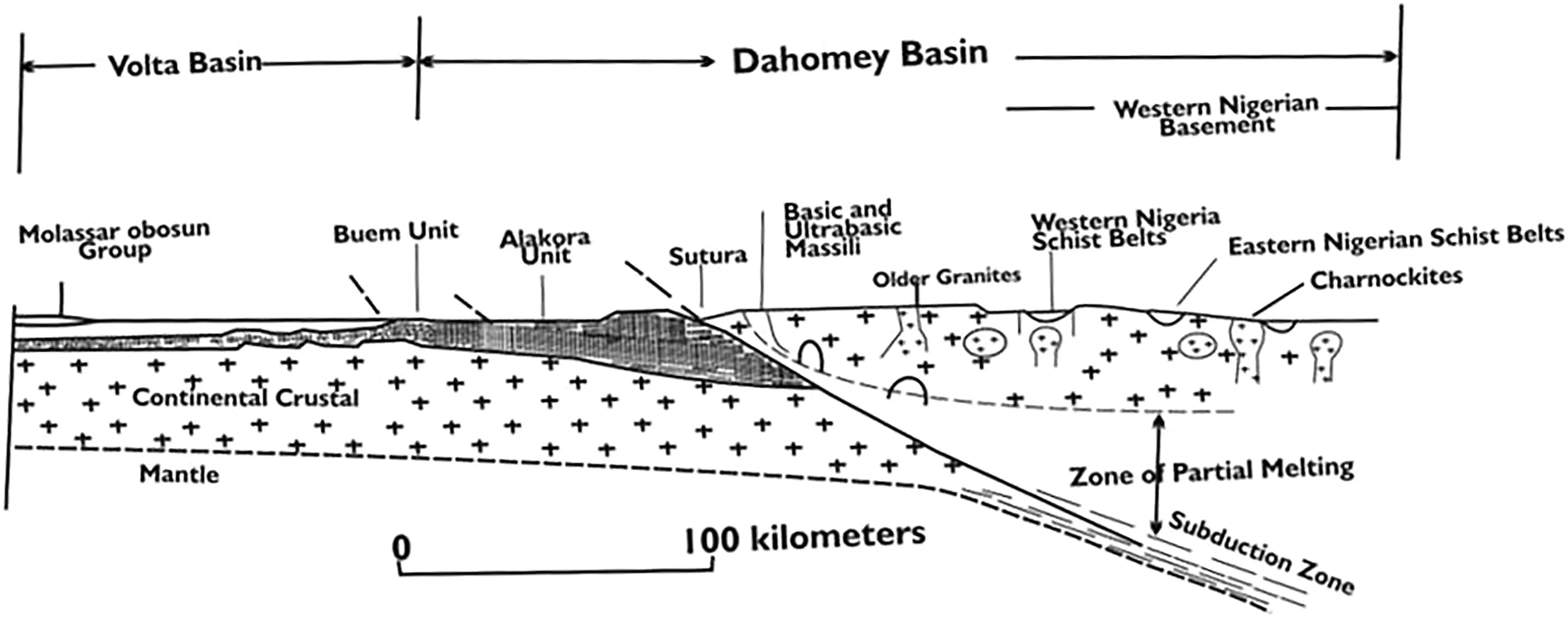
Fig.2 Schematic section across West African margin showing the effects of Pan-African event on the basement of Western Nigerian(modified from Burke and Dewey 1979; Danbatta 2008)
This study is thus aimed at elucidating the geochemical variations of these rocks in the Bunu area to establish the petrogenetic nature of the rocks.This is expected to further lead to the understanding of the geodynamic evolution of the schist belts in the Precambrian terrain of Nigeria.Since the studies of Precambrian schist belts in other parts of the World, those of Nigeria inclusive, are noted for hosting metallic and non-metallic mineral deposits of economic significance, knowledge of geochemical characters of schist belts will not only be of petrogenetic importance but as well contribute to successful mineral exploration in the areas of interest.
1.1 Regional geology
The Nigerian Basement Complex forms part of the Pan-African platform of crystalline rocks. The complex lies within the vast Trans-Saharan Pan-African(500 ± 750 Ma) Mobile Belt of Neoproterozoic(650 ± 200 Ma) age (Caby 1988).
The Damagaran, Adrar des Iforas and Hoggar regions being part of the geologic framework of the Pan-African Mobile Belt occur to the north of the Nigerian Basement Complex (Fig. 1). Bertrand and Caby (1978) established the complex nature of the geology of the Adrar Des Iforas-Hoggar region.
Based on petrological,geochemical,structural mapping,and geotectonic studies, workers like McCurry (1976);Rahaman (1988); Tunbosun et al. (1984) have described the basement to consist of younger low-medium grade metasedimentary and metavolcanic rocks, which form NNE-SSW trending schist belts within the migmatite gneiss complex(Fig. 3)and showed that the Nigeria schist belts are Pan-African and that the Pan-African metamorphic imprint on the earlier basement rocks, especially on the migmatite-gneisses and granitoids, is very important.
Rahaman (1988) subdivided the rock units in the basement of southwestern Nigeria into five (5) major groups viz:
i. Migmatite-gneiss complex which comprise biotite and biotite hornblende gneiss,quartzite,quartz schist and some calc-silicate rocks.
ii. Slightly migmatized to unmigmatized paraschist and metaigneous rocks including pelitic schist,quartzite,amphibolite, marble, talcose, and calc-silicate.
iii. Charnokitic rocks.
iv. Older Granites including granodiorite, granite,tonalite, etc.
v. Unmetamorphosed dolerite dykes (Fig. 3).
The schist belts in northwest Nigeria are separated from those in the southwest by the narrow Nupe Cretaceous basin (Fig. 3). However, there are similarities in age,lithologies,and evolution among these schist belts but their correlation is less clear as the SW region is very poorly exposed and not well defined (Rahaman 1976; and Turner 1983).Ajibade et al.(1989)observed that the southwestern schist belts consist of two distinct generations, one represented by Migmatite-Gneiss Complex (MGC) sequence probably of Archean to Early Proterozoic age and the other believed to be of Late Proterozoic age.
According to Oyinloye (2007) the southwestern Nigerian Basement Complex is said to have evolved through 3 major geotectonic events:
· Initiation of crust forming processes during the Early
Proterozoic (2000 Ma) typified by the Ibadan (Southwestern Nigeria) grey gneisses considered by Woakes et al. (1987) as to have been derived directly from the mantle.

Fig. 3 Geological map of Nigeria showing Bunu area within the SW basement (Inset: Location of Basement Complex of Nigeria between the West African and Congo Cratons) (Modified from Akor and Ogunleye 2014)

Table 1 A modified sequence of events in the SW Basement rocks (modified from Burke et al. 1976; Oyinloye 1998, 2007)
· Emplacement of granites in Early Proterozoic(2000 Ma) and
· The Pan African events (450-750 Ma).
Based on wide geochemical analyses and interpretation,geotectonic studies, field mapping, and plumbotectonics,Oyinloye (1998, 2007) had suggested a modified Burke et al. (1976) sequence of evolutionary events in the Southwestern Nigeria basement complex (Table 1).
2 Methods of study
The Bunu area is part of the Basement Complex of SW Nigeria, located between latitudes 8°00’ N to 8°15’ N and longitude 6°00’E to 6°15’ E. Systematic field mapping of the area was carried out on a scale of 1:50,000 to delineate the major and minor rock boundaries using Aiyegunle SW sheet 226 as the base (topographic) map. The study area that constitutes the northern extension of the N-S trending sector of the Kabba-Lokoja-Igarra schist belt, stretches from Kabba through Iluke to Guguruji, where the sediments of the Bida Basin lie unconformably on the Basement Complex in the eastern part. Field relations of the rock units within the area were systematically determined.
Representative rock samples consisting of six samples of migmatitic-gneiss/migmatized schist, nine samples of quartzite both massive and foliated, and ten samples of quartz-mica schist were collected from the study area along traverse lines and selected for petrographic and geochemical studies. Samples were analysed for major oxides and trace elements at Geoscience Laboratories (Geo Labs),Ontario Geological Survey, Ontario Ministry of Northern Development and Mines Willet Green Miller Centre 933 Ramsey Lake Road Sudbury, Ontario P3E 6B5 Canada.
At Geo Labs, sample preparations include washing,crushing, and pulverizing. Geo Labs uses a variety of sample preparation procedures on a routine basis for geochemical analysis. Closed vessel multi-acid digest was used in solution preparation. This method is employed for the preparation of samples being analyzed by ICP-MS and XRF and it is designed for the thorough dissolution of the silicate rock samples. According to Geo Labs (2015), the rock samples were digested in a closed vessel for total dissolution using a combination of up to four acids (hydrofluoric, hydrochloric, nitric, and perchloric) preferred for the determination of rare Earth elements(REE):La,Ce,Pr,Nd,Sm,Eu,Gd,Tb,Dy,Ho,Er,Tm,Yb,and Lu;high field strength elements (HFSE); Zr, Nb, Hf and Ta and large ion lithophile elements (LILE): Rb, Sr, Cs and Ba plus Y, U, and Th. Y is one of the least incompatible elements associated with the oceanic crust while U and Th are among the most incompatible elements known to be associated with the continental crust.
Geochemical data were processed using precision and accuracy based on a replicate analysis of an internal basalt standard (Talbot and Weiss 1994; Van de Weil 2004) and USGS standard for all elements analyzed (Govindaraju 1998; Geo Labs 2015).
The data were then imported into PETROGRAPH software version 1.0.2 for binary and triangular plotting of various discriminating diagrams.Samples were normalized to chondrite using values presented by Sun and McDonough (1989) for rare Earth elements (REEs) while primordial mantle normalization values of McDonough and Sun(1995)were used for trace element spider diagrams of all the samples using the same software.
3 Results
3.1 Field relations and petrography
The major rock units mapped in the Bunu area as described by Kolawole et al., (2017); Kolawole and Olobaniyi(2018) include gneiss-metasedimentary rocks that cover about 65% of the study area (Fig. 4). These metamorphic sequences were intruded in places by N-S trending undeformed to partially deformed granitoids that form prominent topographic features at the western and south-eastern part of the study area (Fig. 4). The granitic plutons that make up the intrusive suites were generally unfoliated except at the contact with the country rocks where they are weakly foliated with the elongation of feldspar and quartz grains and account for the remaining 35% of the rocks mapped in the area. Granitic rocks in the area consist of fine-medium grained granites at the eastern and northwestern parts, porphyritic granites which are locally porphyroblastic at contacts with host gneiss-metasedimentary rock, and medium-coarse grained granodiorite that forms prominent inselbergs and whaleback-shaped granites that outcrop at the western part (Fig. 4). Garnetiferous granites and weakly foliated varieties outcrop at the northern part.The gneiss-schist and the granitoid were intruded by quartzofeldspathic veins, dolerites, pegmatites, and aplitic dykes. The gneiss-metasedimentary rocks in the area form prominent topographic features especially in western part in villages such as Ohura, Apara and Ora; in the eastern portion in villages such as Ayedero, Ayedayo, and Illah,and in the northern and central parts of the study area in villages such as Ofere-Osomule-Suku axis and Aiyegunle,Otafun, Iluke-Odogbo, Olle-Igbo respectively. Their outcrop patterns especially the migmatite-gneiss and foliated quartzites indicate possibly a refolded fold. They are usually fine-grained and form extensive north-south trending bodies especially migmatite-gneiss, the quartz-mica schist,and the Aiyegunle-Iluke-Olle quartzite ridge (Fig. 4). The Ofere-Suku ridge quartzite is however,east-west trending.Based on these field observations, especially on the competent folded quartzites and generated rosette diagrams,deformations in the area occurred in, at least, two phases:(i) an early phase (D1) related to early foliation (FE)trending in the E-W direction with N-S compressional forces that may be Eburnean in age and (ii) a later phase with NE-SW trending directions with E-W compressional forces (Kolawole et al., 2017). The gneiss-metasedimentary rocks in the area are characterized by a preponderance of quartz rubbles and are usually whitish grey in color.But in areas of prominent iron-staining because of thick overlying lateritic regolith, they are usually brownish-gray in color (Fig. 5).

Fig. 4 Geological map of Bunu area (Aiyegunle SW Sheet 226)

Fig. 5 Outcrops of a migmatite gneiss with leucosome pods of quartz veins (Location: 08°O6’45.8‘‘N; 006°10′31.1’’E), b quartz-mica schist with intruding quartzo-feldspathic veins along Iyah-Aiyegunle Road and c foliated quartzite along Aiyegunle-Iluke road(Location:08°03′2.0‘‘N;006°02′36.1’’E)
The gneiss-schist suite is interbanded in places by short and narrow metabasic dykes and lenses of amphibolite around Osomule and north of Ofere. The amphibolite is dark green in colour and composed of almost shiny black crystals of hornblende on fresh surfaces and brown crusts that characterize weathered surfaces. The fine to mediumgrained amphibolites is a well-foliated rock that consists of abundant green hornblende, plagioclase, and quartz. It is also characterised by the occurrence of quartz and epidote.The rock is characterised by narrow felsic veinlets, 2 to 4 mm in width, parallel to the foliation trend, and consists of quartz and feldspars.
Mineralogical determinations from optical studies show a high proportion of granular quartz and accessory muscovite in the quartz schist. The modal composition of the gneiss-metasedimentary rocks in the area is shown in biotite mineral is pleochroic from brownish to yellowish colour and sometimes has been replaced partially by chlorite and hornblende in the groundmass. Biotite occurs as brownish coloured crystals, poikiloblastic within hornblende, and locally anhedral in shape with dark pleochroic haloes (Fig. 6). At the contacts with granitic plutons,migmatitic-gneiss and migmatized schist could be garnetiferous and hornfelsised with the inclusion of hightemperature minerals like garnet and staurolite. According to Hamidullah et al. (1986), the presence of garnet in the metasediments was probably related to the thermal effects of the emplacement of the granitic magma(Fig. 6a and b).
According to Kolawole and Olobaniyi (2018), quartzmica schist consists of muscovite + chlorite + quartz + albite. This indicates Greenschist Facies while amphibolites’ typical mineral assemblages are Hornblende + Epidote + Chlorite + Quartz, this indicates Epidote-Amphibolite Facies, therefore, metamorphism in the Bunu area reflects Greenschist to Epidote-Amphibolite Metamorphic Facies spectrum. However,higher metamorphic facies resulting from anatexis and inclusion of high-temperature minerals like garnet and staurolite and leading to the formation of migmatitic-gneiss may not be ruled out.
3.2 Geochemical results presentation
The results of twenty-five(25)unaltered and fresh samples of metasedimentary rocks including migmatitic gneiss/migmatized schists, quartz-mica schists, and quartzites analyzed for major oxides, trace elements, and rare Earth element(REE)compositions together with their summaries are presented in Tables 3, 4 and 5 respectively.
Compositionally, the metasedimentary rocks in the area have restricted range of major oxides such as SiO2(av.68.10 wt%for migmatite gneiss,av.61.68 wt%for quartzmica schist and av. 97.45 wt% for both massive and foliated quartzite),Al2O3(av.14.88 wt%for migmatitic gneiss,av.13.17 wt% for quartz-mica schist and av. 1.17 wt% for Table 2 below:
The rock units are composed mainly of quartz and muscovite, biotite and plagioclase. Quartz occurs as small cloudy anhedral grains with wavy extinction and with characteristic weak birefringence, prominently undulose extinction, and low relief. Two generations of quartz were observed; the first one is coarser grained, anhedral, and elongated parallel to the rock fabric, exhibiting wavy extinction while the finer-grained variety occurs as localized granoblastic aggregates with uniform extinction that may likely be of secondary origin.Muscovite occurs as tiny elongate plates with poikilitic crystals of quartz. Hornblende occurs as small xenoblastic crystals greenish in color especially in migmatitic-gneiss and migmatized schist, while tremolite grains tend to be long, prismatic,and usually pleochroic from pale green to dark green. The plagioclase shows albite/polysynthetic twinnings whileboth massive and foliated quartzite wt%). They have low average values of Fe2O3(5.69, 6.32 and 0.19 wt%respectively for migmatitic gneiss, quartz-mica schist and both massive and foliated quartzite), MnO (0.14, 0.09 and 0.01 wt% respectively for migmatitic gneiss, quartz-mica schist and both massive and foliated quartzite),CaO(3.34,2.66 and 0.01 wt% respectively for migmatite gneiss,quartz-mica schist and both massive and foliated quartzite),and P2O5(0.15, 0.21 and 0.01 wt% respectively for migmatite gneiss, quartz-mica schist and both massive and foliated quartzite). The presence of plagioclase feldspar in the gneisses may explain the high Al2O3value with relatively enriched alkalis in migmatite gneiss/migmatized schist and quartz-mica schist than in massive and foliated quartzite (Table 3).

Table 2 Average modal composition of gneiss-metasedimentary rocks from the Bunu area
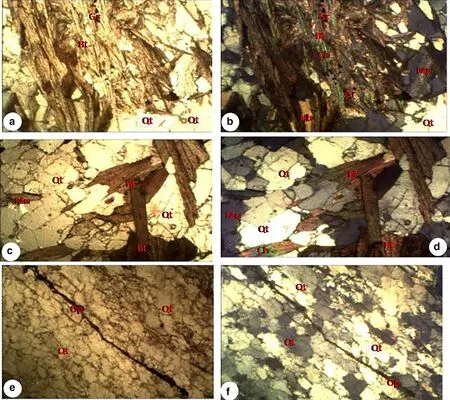
Fig. 6 Photomicrograph of migmatized schist in a plane polarized light and b in cross polar; photomicrographs of quartz mica in c plane polarized light and in d cross polar.photomicrographs of foliated quartzite in(a)plane light and in(b)cross polar light and massive quartzite in(c) plane light. Bt = biotite, Qt = quartz, Ch = chlorite, Gr = garnet, Hb = Hornblende, Mu = muscovite, Op = Opaque (Mag. X 50)
The average Chemical Index of Alteration (CIA),Chemical Index of Weathering (CIW) and Plagioclase Index of Alteration (PIA) values for the metasedimentary rocks vary from 63.69, 74.12, and 0.7% in migmatitic gneiss; 71.78, 82.30 and 0.8% in quartz-mica schist to 74.34,89.76 and 0.87%in quartzite(Table 3)respectively.The average values of Index of Compositional Variation(ICV) for the metasedimentary rocks in the study area are migmatitic gneiss, 1.26; quartz-mica schist/quartz schist,0.9; and quartzite, 0.58, respectively. The calculated averages Discriminant Function (DF) for almost all metasedimentary rocks in the area are negative (Table 2).
The concentrations of most of the trace elements including Ba, Cs, U, Th, Rb, and Pb are generally similar and enriched in all the metasedimentary rocks in the area with average values of 506.63,8.90,2.59,9.89,154.85,and 14.18 ppm respectively in migmatitic gneiss;473.40,6.52,2.93, 9.18, 141.20, and 15.01 ppm respectively in quartzmica schist and 112.13, 0.25, 0.23, 0.88, 10.14, and 3.94 ppm respectively in both massive and foliated quartzites. The rocks are generally depleted Sr, Ti, Be, Mo, Th,and W with 189.25, 3731.33, 2.21, 0.95, 9.8,9 and 1.82 ppm respectively in migmatitic gneiss: 135.20,24,338.82, 2.80, 0.63, 9.18 and 2.47 ppm respectively in quartz-mica schist and 6.20, 257.00, 0.22, 0.21, 0.88 and 0.26 ppm respectively in massive and foliated quartzites(Table 3). Concentrations of average values of HSFE such as Zr (161.67, 231.60, and 56.82 ppm respectively for migmatitic gneiss, quartz-mica schist, and both massive and foliated quartzite), Nb (11.57, 11.96, and 1.02 ppm respectively for migmatite gneiss, quartz-mica schist and both massive and foliated quartzite), and Y (29.44, 22.66 and 2.17 ppm respectively for migmatite gneiss, quartzmica schist and both massive and foliated quartzite),while∑LREE is 124.25, 132.41 and 18.64 ppm respectively for migmatite gneiss,quartz-mica schist and both massive and foliated quartzite.

Table 3 Major oxides compositions (wt%) of metasedimentary rocks of Bunu area

Table 3 continued

Table 4 Trace elements compositions (ppm) of metasedimentary rocks of Bunu area

Average 473.40 2.80 0.84 0.08 13.06 88.70 6.52 20.25 19.57 6.31 0.10 47.88 0.63 11.96 34.51 15.01 141.20 0.05 13.39 2.91 135.20 0.95 9.18 4338.82 0.80 2.93 108.11 2.47 22.66 71.64 231.60 1427.60 10.30 0.84 0.15 26.67 177.00 10.77 35.30 34.03 13.33 0.26 102.10 2.22 22.04 85.70 27.40 364.31 0.11 27.30 7.06 373.10 2.12 17.33 9230.00 1.53 6.30 231.70 8.42 46.04 137.00 513.00 Range 17 KAB47B 16 KAB48B 15 KAB67 14 KAB124 13 KAB127 12 KAB128c 11 KAB50a 10 KAB169H--22.30 0.13-0.84-0.02-0.22--11.00 0.26-1.50-0.35-2.47-0.03-5.30-0.08-0.36-1.10-0.60-2.47-0.04-3.60-1.12-1.70-0.06-0.57-171.00-0.01-0.09-1.50-0.07-0.73-2.00-89.00 192.40 10.30 0.84 0.05 7.77 117.00 1.35 29.00>58 13.33 0.03 102.10 0.08 7.65 13.60 6.50 3.37 0.04 6.90 1.12 31.80 0.61 11.62 3332.00 0.24 2.80 123.40 0.17 11.53 43.00 513.00 429.50 3.20<0.47 0.05 5.39 11.00 10.77 1.50 17.02 3.30 0.13 58.00 0.16 9.68 9.40 7.30 364.31 0.04 3.60>14 19.90 0.91 9.58 1424.00 1.53 3.68 18.00 5.70 17.60 13.00 108.00 22.30 0.13<0.47 0.02 0.22<3 0.26 2.60 0.35<0.14<0.0018 5.30<0.08 0.36 1.10 0.60 2.47<0.04<1.1<0.16 1.70 0.06 0.57 171.00 0.01 0.09 1.50 0.07 0.73 2.00<6 493.70 2.04<0.47 0.07 21.33 93.00 9.14 12.70 22.46 6.76 0.07 52.10 0.10 12.22 58.70 23.60 196.17<0.04 21.20 1.97 156.50 0.79 8.27 6085.00 1.13 3.00 137.20 0.97 46.04 127.00 257.00 896.70 2.14<0.47 0.11 23.94 139.00 9.36 34.10 21.77 8.85 0.08 58.50 2.22 17.89 72.30 16.90 135.14<0.04 20.20 2.20 224.40 1.16 12.87 7514.00 0.74 3.11 172.80 1.54 36.04 116.00 322.00 1427.60 2.39<0.47 0.13 26.67 177.00 10.66 27.30 27.61 8.95 0.12 71.20 1.70 20.07 85.70 18.50 163.04<0.04 27.30 2.94 249.20 1.32 17.33 9230.00 0.85 3.91 231.70 3.79 38.12 137.00 332.00 222.80 3.08<0.47 0.04 16.98 128.00 9.87 13.40 34.03 5.88 0.13 34.10 0.62 22.04 30.80 27.40 83.42 0.04 8.40 7.06 60.50 1.60 10.56 7226.00 1.35 2.78 167.00 3.16 7.63 79.00 206.00 106.50 0.87<0.47 0.03 1.94 19.00 5.46 4.90 20.29 4.66 0.26 39.70 0.26 15.77 4.30 5.80 336.61 0.04 5.80>14 14.30 2.12 8.95 1365.00 1.34 6.30 22.30 8.42 9.35 41.00 162.00 Quartz-Mica Schist/Quartz Schist 9 KAB198A 8 KAB125 7 KAB116 Trace Elements (ppm)502.70 2.14<0.47 0.05 11.96 52.00 3.05 33.30 18.98 4.28 0.07 14.60 0.16 10.65 18.90 14.00 107.48 0.11 9.90 4.01 92.30 0.84 10.25 3660.00 0.62 2.74 84.90 1.58 31.06 78.00 155.00 545.70 2.61<0.47 0.15 14.25 97.00 7.03 28.70 19.63 4.65 0.07 52.90 0.54 9.68 40.30 25.60 96.26<0.04 18.70 2.35 373.10 0.70 7.65 4854.00 0.61 2.41 141.00 1.00 31.69 89.00 172.00 367.50 1.87<0.47 0.13 13.21 54.00 4.77 35.30 13.52 2.47 0.05 38.20 0.41 5.54 44.50 18.90 64.92<0.04 11.90 1.62 263.50 0.39 3.37 2866.00 0.41 1.38 89.40 0.72 19.50 63.00 89.00

Average 112.13 0.22 0.47 0.02 0.26 10.80 0.25 2.74 1.51 1.47 0.01 3.33 0.21 1.02 0.83 3.94 10.14 0.06 1.63 0.41 6.20 0.08 0.88 257.00 0.05 0.23 4.85 0.26 2.17 5.00 56.82 234.50 0.41 0.47 0.03 0.42 49.00 0.69 4.90 3.41 4.94 0.01 7.90 0.56 2.98 1.10 15.90 22.05 0.07 1.90 0.82 14.10 0.22 2.03 860.00 0.08 0.46 13.00 0.54 4.29 11.00 195.00 Range 28 KAB137 27 KAB152 26 KAB110 25 KAB95B 24 KAB96 23 KAB08B 22 KAB49A 21 KAB55 20 KAB52B 8.20-0.09-0.47-0.01-0.16-3.00-0.03-1.40-0.14-0.40-0.00-0.60-0.08-0.05-0.70-0.20-0.76-0.04-1.20-0.21-1.60-0.03-0.08---16.00 0.01-0.04-0.90-0.07-0.35-2.00-17.00 113.80 0.20<0.47 0.02 0.20 6.00 0.19 2.90 1.60 1.51 0.01 0.90 0.24 1.00<0.7 15.10 13.50 0.07<1.1 0.37 6.90 0.07 0.82 236.00 0.06 0.29 3.20 0.24 4.29 9.00 58.00 28.60 0.17<0.47 0.02 0.17 6.00 0.39 2.40 1.26 1.07 0.01 1.00 0.56 1.58<0.7 1.70 11.47 0.07 1.20 0.35 1.60 0.10 1.27 357.00 0.06 0.23 6.20 0.44 2.53<1.8 39.00 234.50 0.41<0.47 0.03 0.42 14.00 0.32 4.90 3.41 4.94 0.01 1.10 0.09 2.98 1.10 2.80 22.05<0.04 1.90 0.58 14.10 0.22 2.03 860.00 0.08 0.46 13.00 0.54 2.07 5.00 195.00 114.20 0.23<0.47 0.02 0.28 6.00 0.20 4.00 1.81 1.86 0.01 1.20 0.40 0.94<0.7 15.90 14.88 0.04<1.1 0.41 7.00 0.07 0.89 232.00 0.06 0.29 3.50 0.20 3.90 11.00 74.00 39.40 0.22<0.47 0.02 0.30 3.00 0.28<1.4 0.58 0.78 0.00 0.60 0.08 0.67<0.7 0.70 4.27<0.04<1.1 0.82 4.60 0.06 0.92 143.00 0.02 0.18 1.60 0.14 2.14 2.00 26.00 221.60 0.23<0.47 0.02 0.16 5.00 0.26<1.4 2.00 0.99<0.0018 3.20 0.22 0.68<0.7 1.30 11.84<0.04<1.1 0.21 8.90 0.05 0.67 223.00 0.08 0.23 4.20 0.07 2.09 3.00 37.00 8.20 0.09 0.47 0.01<0.13<3 0.03 1.40 0.14 0.40<0.0018 5.10<0.08 0.05<0.7 0.20 0.76<0.04<1.1<0.16<0.6<0.007 0.08 16.00 0.01 0.04 0.90<0.05 0.35 2.00 17.00 223.10 0.29<0.47 0.02 0.29 10.00 0.21 2.60 2.35 1.51 0.01 6.40 0.08 1.56<0.7 2.20 12.07<0.04 1.80 0.43 6.30 0.09 1.23 357.00 0.05 0.29 12.40 0.45 2.57 4.00 58.00 78.30 0.17<0.47 0.02 0.26 5.00 0.15 2.30 0.99 0.65 0.00 7.90 0.08 0.64 0.70 0.90 6.02<0.04<1.1 0.23 2.60 0.04 0.71 147.00 0.03 0.14 5.10 0.20 1.74 3.00 26.00 Massive /FoliatedQuartzite 19 KAB46 18 KAB41 SerialNo SampleNo Trace Elements (ppm)119.30 0.29<0.47 0.02<0.13 4.00 0.69 1.40 1.52 1.45 0.00 2.80 0.15 0.75 0.70 1.80 10.47<0.04<1.1 0.32 4.80 0.05 0.53 142.00 0.05 0.19 1.80 0.08 1.13 6.00 56.00 52.40 0.15<0.47<0.013<0.13 49.00 0.08<1.4 0.91 1.03<0.0018 6.40<0.08 0.42<0.7 0.70 4.23<0.04<1.1<0.16 5.20 0.03 0.54 114.00 0.02 0.18 1.40<0.05 1.09<1.8 39.00 Ba Be Bi Cd Co Cr Cs Cu Ga Hf In Li Mo Nb Ni Pb Rb Sb Sc Sn Sr Ta Th Ti Tl U VW Y Z n Zr

Table 5 Rare Earth elements compositions (ppm) of metasedimentary rocks of Bunu area

Table 5 continued
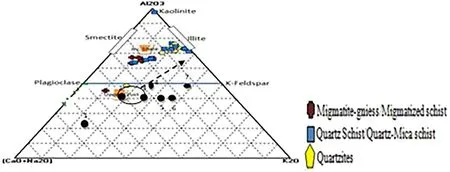
Fig. 7 Ternary plot of molecular proportions Al2O3-(CaO + Na2O)-K2O for the metasedimentary rocks from Bunu area relative to average Post-Archean shale from Taylor and McLennan(1985)and composition of typical magmatic rock types(Fedo et al.1995).1.gabbro;2.tonalite;3. granodiorite; 4. granite; 5. A-type granite; 6. charnokite and 7. potassic granite (Nesbitt and Young 1984) and Index calculated weathering trend of UC of Von Eynatten et al. (2003) is shown by
4 Discussion
(A) Classification of the protolith
Low values of CaO, Na2O, and Sr together with high K2O indicate that the protoliths were mature sediments(Weaver 1989; Olobaniyi 2003). Enrichment of Zr and Y of 161.67 and 29.44 ppm in migmatitic gneiss and 231.60 and 22.66 (ppm) respectively in mica schist may be attributed to a derivation of their protolith sediments from igneous sources (Lambert et al. 1982; Adedoyin et al.2014). The higher concentration of alkali components(Na2O and K2O)and Rb in metasedimentary rocks relative to the meta-igneous rocks or amphibolite are unlikely to reflect the original chemistry of the magma but probably an indication of some degree of metasomatism (Odigi 2002).
Generally, it is obvious that both the major oxides, and trace elements, including rare earth compositions of the gneiss-schists members from the Bunu area approximate that of Post-Archean terrigenous Shale (PASS) of Taylor and McLennan(1985).As illustrated on the ternary plot of Al2O3-(CaO + Na2O)-K2O for metasedimentary rocks(Fig. 7), most gneiss-metasedimentary rocks from the area plot close to average shale with quartzite mostly tend to illite compositions and almost toward the Al2O3-apex of the diagram attesting to depletion of CaO and NaO with the removal of K2O. This A-CN-K diagram can be used to characterize the weathering of rocks (Nesbitt and Young 1982, 1984 and 1989; McLennan 1989, 1993;and Wollast and Cho 1992). The aforementioned authors were of the view that early stages of weathering are characterized by depletion in CaO,NaO,and K2O,whereas late or advanced stages of weathering are characterized by the removal of K2O resulting in the formation of sediments that later metamorphosed to metasedimentary rock in the area. High Al2O3, Rb, and Y of 13.17 wt%, 154.85 and 29.44 ppm in migmatitic gneiss, 18.99 wt%, 141.20 and 22.66 ppm in mica schist and 11.43 wt%, 10.14 and 2.17 ppm in quartzite respectively may suggest that the original argillite contains some plagioclase and from index calculated weathering trend of Von Eynatten et al. (2003), the protolith of most of the quartzites and quartz-mica schists from Bunu could have tonalite-granodiorite-granite compositions (Fig. 7).
In Fig. 7, the quartzite, quartz-schist, and quartz-mica schist plot is close to illite whereas the migmatitic gneiss and migmatized schist are close to average shale. These plots are similar to that of metasedimentary rocks of Okemesi, SW Nigeria, where most of the quartzites and biotite schists plot close to illite and kaolinite fields while quartz-schist plot close to average shale (Okunlola and Okoroafor, 2009).

Fig.8 a MgO-CaO-Al2O3 diagram of Leyreloup et al.(1977)and b plot of Na2O/Al2O3 against K2O/Al2O3 of Garrels and McKenzie(1971)of the gneiss-metasedimentary rocks of Bunu area
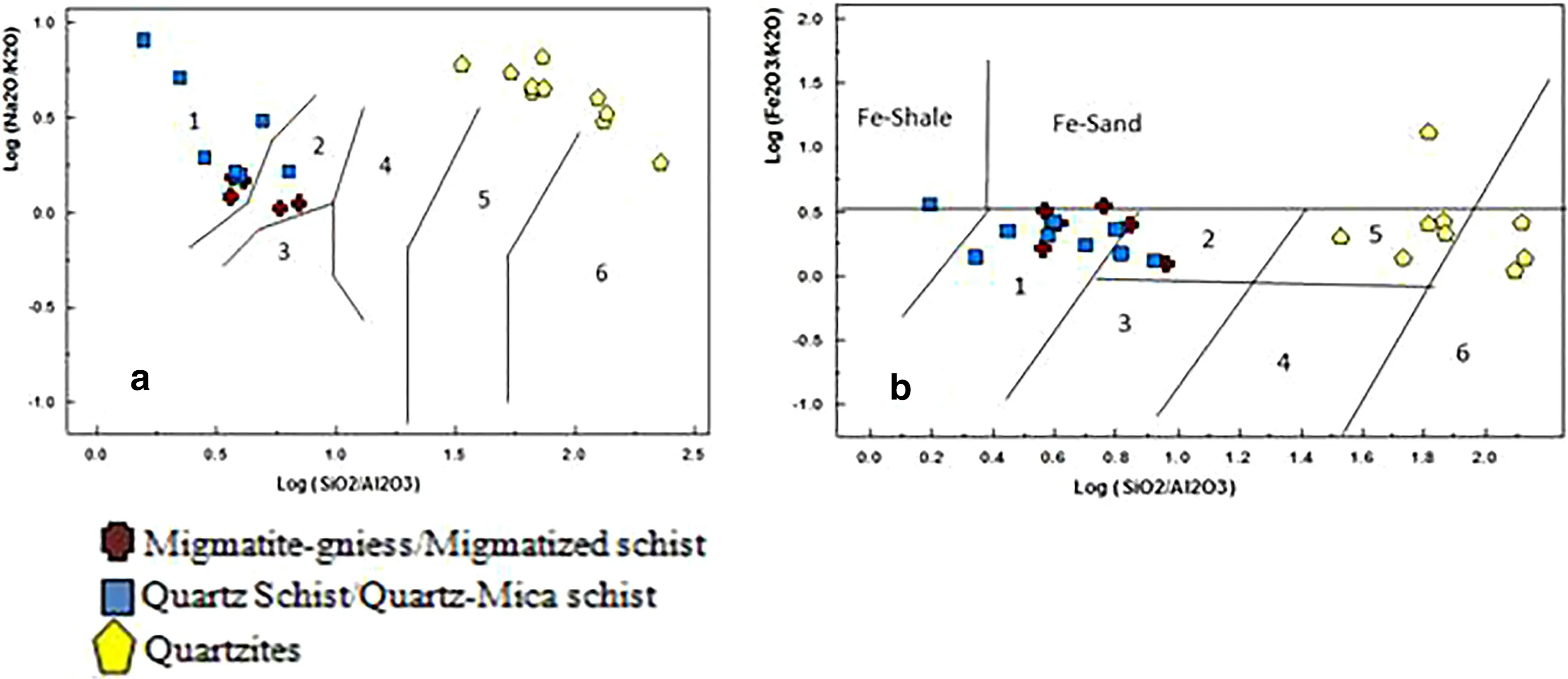
Fig. 9 The compositional classification of metasedimentary rocks from the study area after a Pettijohn (1975) and b modified from Herron(1988). Fields are: 1. Greywackes; 2. Litharenite; 3. Arkose, 4. Subarkose, 5. Sublitharenite, 6. Quartz arenite
To further understand the parent material of the metasedimentary rocks in the area, some discriminant diagrams have been employed. On the MgO-CaO-Al2O3diagram of Leyreloup et al. (1977), the metasedimentary rocks plot outside the magmatic field thus indicating that they have sedimentary protolith (Fig. 8a), similar to the quartz-mica schist from Egbe-Isanlu area (Olobaniyi,2003). The protolith of the rocks can also be determined using a Discriminant Function (DF) as long as the MgO <6% and SiO2<90% for all quartzofeldspathic rocks (Shaw 1972).

Positive DF values suggest an igneous origin while negative DF values indicate sedimentary source material. So,since all calculated average DF values of almost all metasedimentary rocks in the area are negative, it then means that their protoliths are of the sedimentary source.
On the Na2O/Al2O3against K2O/Al2O3discrimination diagrams of Garrels and Mckenzie (1971) (Fig. 8b); the gneiss-metasedimentary rocks distinctively plot within the sedimentary field. It is inferred that migmatitic gneisses/migmatized schists, quartzites, and quartz-mica schists from the Bunu area are of the sedimentary source/protolith.
The sedimentary origin of the parent rocks for the metasedimentary rocks of the area was indicated on the plot of chemical maturity diagram of [Log (Na2O/K2O) vs Log (SiO2/Al2O3] after Pettijohn (1975) and modified diagram of [Log (Fe2O3/K2O) vs Log (SiO2/Al2O3] after Herron (1988) (Fig. 9a and b). On these diagrams, the migmatitic gneisses and quartz-mica schists plot in the compositional fields of greywackes and litharenite (subgreywacke) while massive and foliated quartzites plot within the field of sublitharenite and quartz arenite.
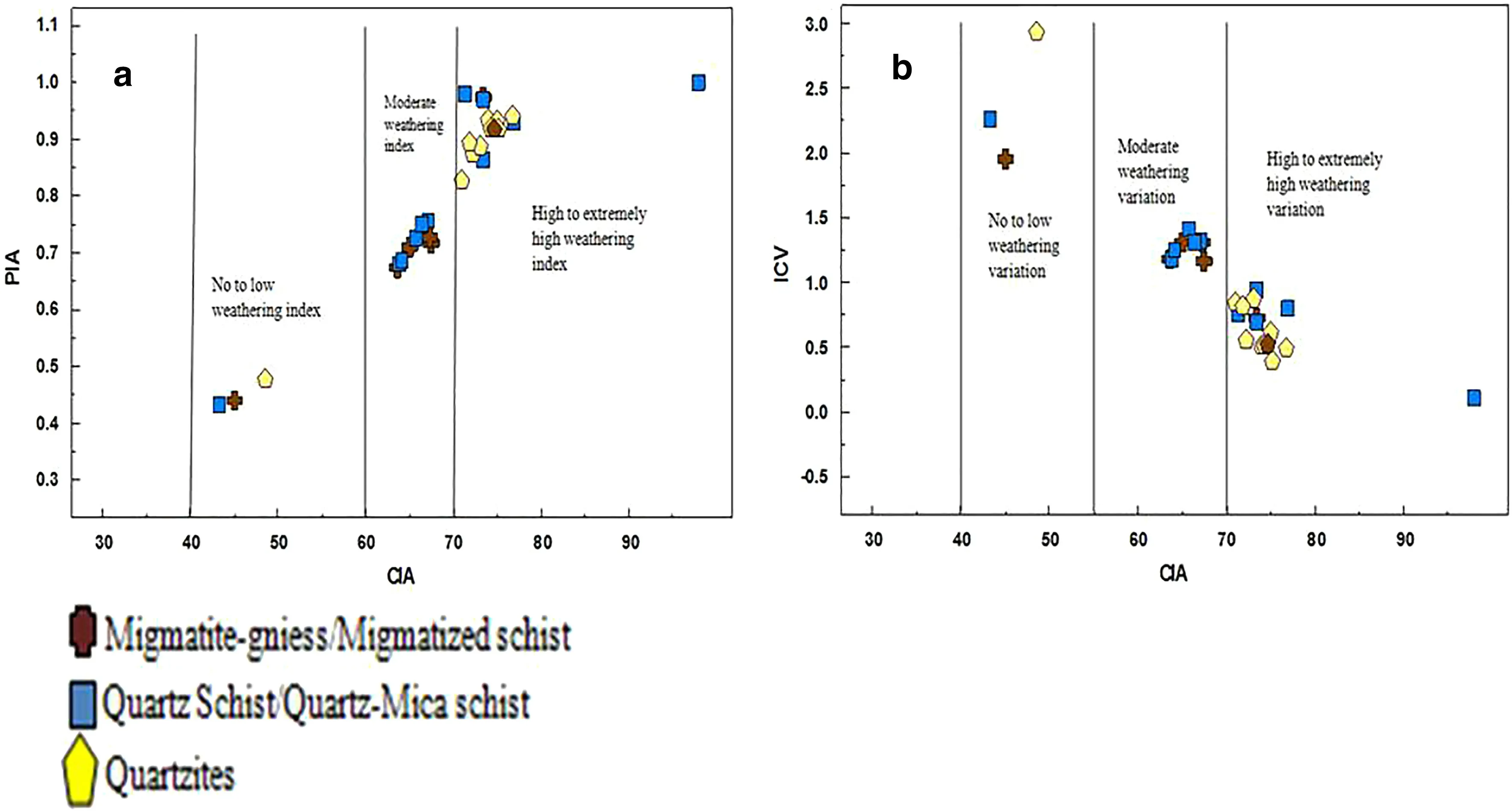
Fig.10 a Plot of PIA against CIA and b CIA vs ICV for the rocks in the study area indicating that all the rocks in the area plot in the Low CIA inference field (CIA = 80) (after Nesbitt and Young (1982)
Quartz arenite-shale associations are generally regarded to be formed from recycled sediments or materials derived from weathering processes under low relief conditions as well as under low rate of sedimentation (Suttner et al.1981; Okonkwo 2005). Such conditions are obtained in stable cratonic environments.Studies have also shown that first-cycle quartzite can be formed under a unique combination of tectonic and climatic conditions. These include prolonged transport involving slow rate of sedimentation or prolonged alluvial storage associated with low relief and severe tropical weathering conditions (Suttner et al.1981).
These trends are similar to that of metasedimentary rocks from the Isanlu area where the quartz-mica schist is plotted within greywackes and litharenite(subgreywackes)fields (Olobaniyi 2003). The quartzites from this area are also similar to the Okene-Lokoja quartzitic schist that have an arenite antecedent (Ezepue and Odigi 1994) and the Ibadan quartz schist that plotted almost entirely within the arenite field (Okunlola et al. 2009).
(B) Sediment maturity of the protolith and provenance tectonic setting
According to Odewumi et al. (2016) chemical patterns and compositions of rock protolith are often preserved throughout paleoweathering profiles of weathering, diagenesis, and metamorphism. The concept of geochemical proxies of mineral alteration (that is weathering indices)relies on the selective removal of soluble and mobile elements from a weathering profile compared to the relative enrichment of rather immobile and non-soluble elements(Nesbit and Young 1982; Odewumi et al. 2016).
The degree of weathering and sediment maturity of the protolith was estimated through the Chemical Index of Alteration (CIA) proposed by Nesbitt and Young (1982),the Chemical Index of Weathering (CIW) proposed by Harnois (1988), Plagioclase Index of Alteration (PIA)proposed by Fedo et al.(1995)and Index of Compositional Variability (ICV) of Cox and Lowe (1995). They are defined as:

CIW, PIA, and ICV were used to determine the degree of weathering of the protolith of the rocks in the study area.The ICV, in addition, calculates the concentration of alumina with respect to other major constituents of the rock but SiO2.
From Fig. 10a, it can be deduced that the protoliths of the rocks of the study area have suffered a low degree of weathering because all CIA of the sampled rocks is below 80%with very low <1%of PIA as advanced by Adedoyin et al. (2014) and Odewumi et al. (2016). This indicates moderately high to low weathering of the rocks in the area thus suggesting that the protolith of the quartzite is more mature than those of quartz-schist and migmatite gneiss.The quartzite and associated quartz-mica schists are believed to represent products of more intensely weatheredfelsic source rocks, which have been subjected to prolonged transportation, sorted, and deposited under unstable marginal environments. CIA of 45-55% is indicative of lack of weathering (Depetris and Probst 1998), CIA of Upper Crust (56.93), and CIA values for Post Archean Australia Shale (PAAS) is 75.30 (Taylor and McLennan,1985). Stoichiometric albite has a CIA value of 50, and stoichiometric anorthite has a CIA value of 33 (Sheldon et al. 2002). The CIA of metasedimentary rocks from the plot is similar and close to PAAS (Fig. 5) with most plotting between 70-80% (Fig. 10a and b). The plots of CIA vs PIA and ICV vs CIA of Nesbitt and Young (1982)(Fig. 10a and b)show that while most migmatitic-gneisses and quartz-mica schists in the study area are moderately weathered, most foliated and massive quartzites rocks are highly weathered.
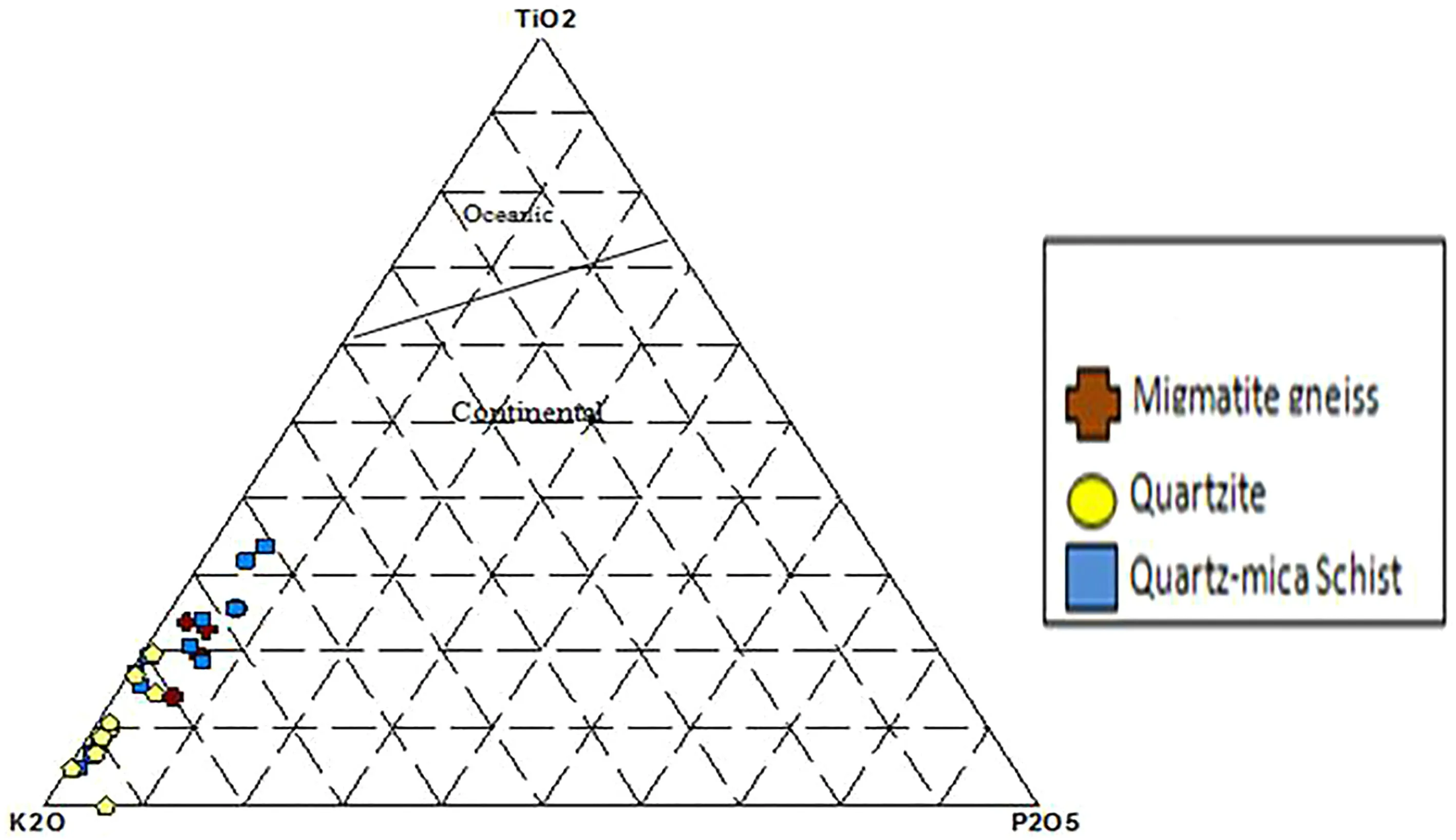
Fig. 11 TiO2-K2O-P2O5 diagram for the Bunu area metasedimentary rocks (after Pearce 1975). This shows the continental origin of the schists
In comparison, quartz schist from Igarra area has an average CIA value of 53.9% (Okeke and Meju 1985).Those of Jakura are 62.12% (Elueze and Okunlola, 2003),Ibadan quartzite schist is 57% on average (Okunlola et al.,2009) while Egbe-Isanlu ranges from 46.52-67.53%(Olobaniyi 2003). Therefore, the metasedimentary rocks from Bunu area show moderate to extremely higher degree of weathering than those from other regions.
Normally and compositionally, immature rocks have high ICV, relative to mature rocks with very little nonsilicate clay mineral with low values of usually <0.6(Elueze and Okunlola, 2003). The values for quartz-mica schists and quartzites show moderate to high compositional maturity, which reflects the moderate intensity of weathering of the source rocks before metamorphism, whereas migmatitic gneiss was formed from immature rocks.

Fig. 12 Discriminant function diagrams for a the provenance signature of the rocks in the Bunu area (after Roser and Korsch 1988) and b the depositional fields (after Bhatia 1988)
To determine the provenance and tectonic setting of the metasedimentary rocks of the Bunu area, the TiO2-K2OP2O5ternary plot of Pearce(1975)(Fig. 11)was used.This diagram essentially discriminates between rocks formed in oceanic from those of continental tectonic environments.All the metasedimentary samples fall within the continental field thus suggesting that the protolith of these rocks is continental.
Roser and Korsch (1988) also evolved discriminant functions involving the use of major elements to distinguish between sediments derived from felsic, intermediate and,mafic igneous provenances and quartzose sedimentary provenance and environment of deposition (Fig. 12a). The metasedimentary, especially migmatitic gneiss, schist, and quartz mica schist samples plot between felsic igneous and quartzose sedimentary provenance while the quartzites plot entirely on quartzose sedimentary provenance field in a passive continental margin tectonic setting (Fig. 12a and b).
The discriminant functions used after Roser and Korsch(1988) in Fig. 12a are :
Discrimination function 1:

Discrimination function 2:

The discriminant functions used after Bhatia (1988) in Fig. 12b are:
Discriminant function 11:
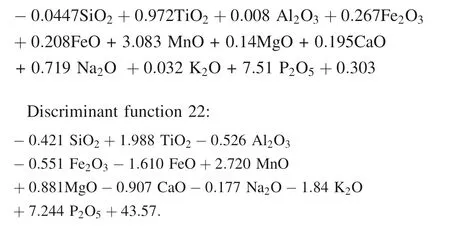
These plots are similar to the schistose rocks from Egbe-Isanlu(Olobaniyi 1997,2003),Lafiagi-Osi area(Adedoyin et al. 2014; ), Ibadan area (Okunlola et al. 2009) and Okemesi (Okunlola and Okoroafor, 2009) all in SW Nigeria basement. These authors interpreted the schistose rocks in these areas to have felsic igneous and quartzose sedimentary sources deposited in a passive margin setting.
This geochemical characterization of the metasedimentary rocks indicates that their protoliths were mature subgreywacke to greywacke-type sediments derived from predominantly granitic provenance. The mature nature of the protolith sediments suggests genesis, and/or tectonic stable and passive continental margin environment from which the sediments were derived. According to Barshad(1966),Weaver(1989),and Olobaniyi(2003),these mature materials are characteristic of stable environments associated with sediment recycling that may be produced from very strong chemical weathering of first-cycle material.
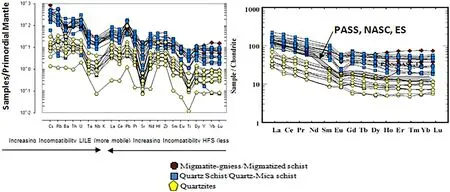
Fig.13 a Primordial mantle-normalized incompatible trace element patterns,normalizing values are those of McDonough and Sun(1995)and b REE patterns of metasedimentary rocks from Bunu area compared to PASS (post-Archean average Australian Sedimentary rock), NASC(North American shale composite),and ES(European shale)after Murphy(2001)(Normalizing values are those of Sun and McDonough 1989)
In a plot on the Primordial mantle-McDonough and Sun(1995), the distribution patterns of the trace elements in these rocks are rather flat with significant enrichment in Ba and Rb in metasedimentary rocks especially in migmatised gneisses and mica schists than in foliated and massive quartzites (Fig. 13a). This suggests their derivation from the differentiated felsic precursors. The similarity in distribution and concentration of trace elements,especially in gneiss-schist rocks, shows that the processes controlling their distribution during and after sedimentation remain rather similar.
The rare Earth elements (REEs) belong to a coherent group of elements characterized by a similar ionic radius and trivalent oxidation state in most physicochemical environments in the Earth crust (Best 2003). However,various fractional processes are known to have effect on their distribution in natural systems. This usually becomes apparent as anomalies or enrichment/depletion trends when the REEs are normalized against well known standards such as Post-Archean Average Australian Shale (PASS),North American Shale Composition(NASC)and European Shale(ES)(Rollinson 1993;Murphy 2001).REEs and high field strength elements (HFSE), including Y, Zr, Ti, Nb,Ta, Th, Sc, Hf, and Co are the most suitable and useful indicators for provenance determination of sedimentary and metasedimentary rocks because of their relatively low mobility during diagenesis and metamorphsim(Taylor and McLennan 1985; Nyakairu and Koeberl 2001). The REEs data of all of these samples from the area normalized to chondrite after Sun and McDonough (1989), compare and show that similarity exists between the PASS, NASC and ES standards and the samples from the area with respect to LREE and HREE. This suggests that the metasedimentary rocks from the study area have similar compositions and may have similar sedimentary sources as affirmed by the average DF values (Fig. 13b).
As seen in Fig. 13b, the LREE are enriched and the HREE patterns are almost flat, these indicate that the sources of the protolith of these metasedimentary rocks are felsic and from the negative Eu anomaly, it is evident that the felsic source is highly differentiated and similar to granite (McLennan 1989; Taylor and McLennan 1985).The relative enrichment of incompatible elements (LREE,Th) over compatible elements (Sc, Co) in the metasedimentary rock samples from this area indicate felsic average provenance compositions (Culler et al. 1988; McLennan et al. 1993).
According to Winchester and Max(1989)enrichment of LILE like Cs, Pb, Ba Pb and Na with broadly curving profiles of all the metasedimentary rocks from the study area indicates samples with continental arc and active margin tectonic settings while oceanic arc profiles are characterized by depletion in many elements relative to PASS.
Bhatia and Crook(1986)identified the elements La,Th,Zr, Nb, Y, Sc, Co, and Ti as the most useful in discriminating greywacke samples from different tectonic environments.On trivariate plots of La-Th-Sc and Th-Sc-Zr/10 most of the greywacke samples (Migmatitic-gneiss and quartz-mica schist) from the area plot in the Continental Island Arc and Passive Continental Tectonic Environments(Fig. 14a and b).

Fig.14 a La-Th-Sc and b Th-Sc-Zr/10 discrimination diagrams for greywackes samples from the Bunu area(after Bhatia and Crook 1986).The fields are: A = Oceanic Island; B = Continental Island arc; C = Active Continental Margin; D = Passive Margin
5 Conclusions
The metasedimentary rocks of the Bunu area, southwest Nigeria consist of migmatised gneisses and schists,quartzmica schists,and foliated/massive quartzites that have been reworked. These rocks are interbanded with amphibolites and were all intruded in places by granitoids and minor intrusions such as mafic and felsic dykes.The major,trace,and REEs data of the metasedimentary rocks of this study show higher values of Na2O, MnO, and Nb and depleted mean values of FeO and MgO relative to the composition of normal metasediments. This enrichment-depletion signature may not be unconnected with the movement of metamorphic remobilised fluids within the Bunu area during the Pan-African or earlier events.
Additional geochemistry of the rocks under study shows that whereas the protolith of the reworked migmatised gneisses/schists and quartz-mica schists are greywackes to litharenites in composition, that of quartzites are sublitharenites to quartz arenites and they are all derived mainly from predominantly felsic igneous to quartzose sedimentary provenance and mostly emplaced in passive continental margins. The maturity level of the protolith points to rapid subsidence of the basin during its genesis.It could equally be interpreted to show tectonic stability in the surrounding environment from where the sediments were sourced.
The weathering characteristics of the metasedimentary rocks in the area show that the protolith of the quartzite is more mature than those of quartz-schist and migmatitic gneiss.The quartzite and associated quartz-mica schists are believed to represent products of more intensely weathered felsic source rocks, which have been subjected to prolonged transportation, sorted, and deposited under passive/inactive continental margin environments. The rocks correlate well with those found elsewhere within the southwestern part of the Nigerian Basement Complex.
Author contributionAs we equally contributed to get the manuscript to its present form. The position of the authors in the manuscript: M.S. Kolawole, E.C. Chukwu and A.N. Agibe, is merely a reflection of seniority in office.
Declarations
Conflict of interestOn behalf of all authors, the corresponding author states that there is no conflict of interest among the authors.
杂志排行
Acta Geochimica的其它文章
- Genesis and soil environmental implications of intact in-situ rhizoliths in dunes of the Badain Jaran Desert, northwestern China
- Element migration and enrichment characteristics of bedrock–regolith–soil–plant continuum system in the chestnut planting area,Chengde, China
- Geochemical evaluation of mineralization potential of the Somie-Ntem area within the Tikar plain, Cameroon: implication on petrogenesis
- Geodynamic signif icance and genesis of chromitites from the Islahiye ophiolite (Gaziantep, SE Anatolia) as constrained by platinum group element (PGE) compositions and mineral chemistry characteristics
- Hydrogeochemical processes and multivariate analysis for groundwater quality in the arid Maadher region of Hodna,northern Algeria
- Identification of terrigenous and autochthonous organic carbon in sediment cores from cascade reservoirs in the upper stream of Pearl River and Wujiang River,southwest China:lignin phenol as a tracer
